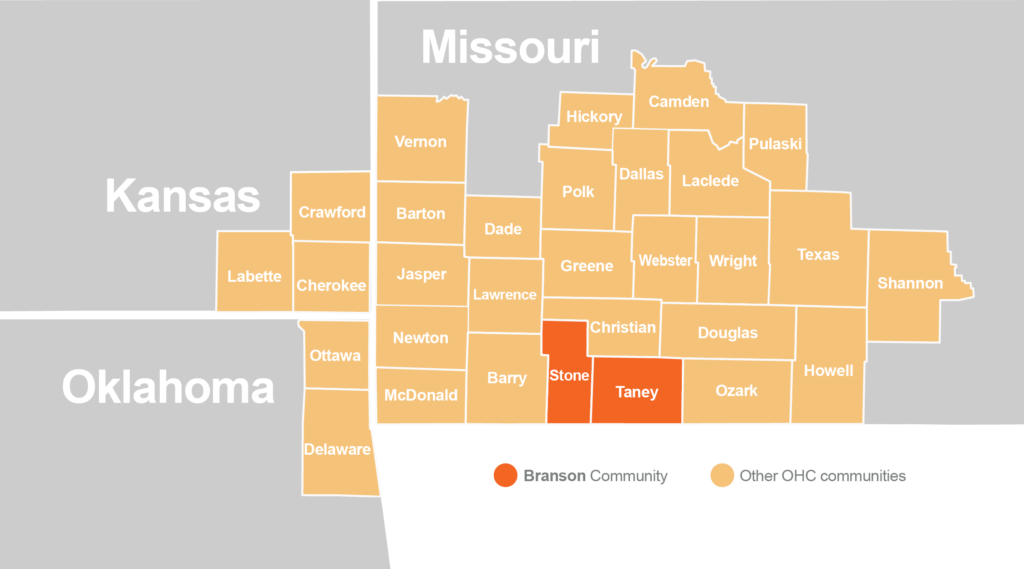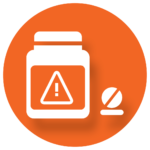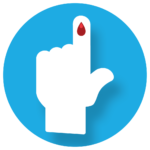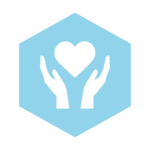
Service Area
The Branson Community is made up of 2 Missouri counties: Taney and Stone. The counties included in the Branson Community were based on the catchment area of the participating hospital, CoxHealth Branson and the local health departments of Taney and Stone counties.
The Branson Community is home to 86,729 individuals per the 2020 census, an increase of 3.9% from the 2010 census. The area includes state parks, lakes, rural communities, villages, small townships, unincorporated communities and 19 cities, including Branson, Hollister, Forsyth, Galena, Kimberling City and Branson West, to name a few.
Locals and visitors enjoy diverse recreational and entertainment opportunities. Branson is the most populated city between Stone and Taney counties, at 11,400 people. In 2019, 9.1 million tourists visited the area, a record since tracking began in 1993.
Population Overview
The Commission noted several important demographic and population trends within the two-county Branson Community. Nearly 19.6% of Community residents are minors under the age of 17, while approximately 39.6% are over the age of 55. Meaning that the population is, on average, older than both the Region and the nation. Older residents are more likely to be living with chronic illnesses and require access to more health services. Further, approximately 56% of the Community is within the age grouping of 18-64, which drives the workforce in the community.
Approximately 18% of the total population is living with a disability, which is higher than the regional rate of 17.3% and the national rate of 12.62%. This may contribute to access to care and disparities amongst the disability community members.
Vulnerable populations, such as people in poverty, minorities, and the elderly, often experience higher rates of chronic illness and worse health outcomes. To ensure vulnerable and at-risk populations were considered when identifying and addressing community health needs, the Commission identified them in each Community using the Center for Disease Control and Prevention (CDC) Social Vulnerability Index (SVI). Using U.S. Census and American Community Survey data, the SVI identifies the most vulnerable groups across all comparative census tracts. Out of the highest vulnerability score of 1.0, the Branson Community has an overall SVI score of 0.7, meaning that this community is more vulnerable than 70% of the rest of the counties in the OHC Region. Scores for Socioeconomic Status (0.6), Household Composition and Disability (0.7), and Housing and Transportation (0.8) demonstrate significant vulnerability of the local population. Homeless students’ status (4.0) is below the OHC region (4.2), but equal to Missouri (4.0) and better than the United States (3.0). This is an area of concern.
What makes a population vulnerable?
| Stone County | Taney County | Branson Community | ||
|---|---|---|---|---|
| Socio-Economic Status | Below Poverty | 0.18 | 0.59 | 0.39 |
| Unemployed | 0.78 | 0.66 | 0.72 | |
| Income | 0.15 | 0.66 | 0.4 | |
| No High School Diploma | 0.55 | 0.28 | 0.42 | |
| Household Composition & Disability | Aged 65+ | 0.99 | 0.75 | 0.87 |
| Under Age 18 | 0.03 | 0.21 | 0.12 | |
| Disability Status | 0.72 | 0.59 | 0.65 | |
| Single-Parent Households | 0.01 | 0.78 | 0.39 | |
| Minority Status & Language | Minority | 0.25 | 0.71 | 0.48 |
| Speaks English “Less than Well” | 0.32 | 0.78 | 0.55 | |
| Housing Type & Transportation | Multi-Unit Structures | 0.86 | 0.98 | 0.92 |
| Mobile Homes | 0.73 | 0.75 | 0.74 | |
| Crowding | 0.5 | 0.78 | 0.64 | |
| No Vehicle | 0.21 | 0.46 | 0.34 | |
| Group Quarters | 0.26 | 0.68 | 0.47 | |
| Orange highlight: The population in this county is more vulnerable than 90% of all other counties in its respective state. | ||||
| Blue highlight: The population in this county is more vulnerable than 85% of all other counties in its respective state. | ||||
indicative of greater vulnerability. Percentiles are from the CDC’s SVI data.
Assessed Health Issues
Commission stakeholders began the RHA process with analysis of publicly available health data (secondary data) and participating health systems’ emergency room utilization data (primary data) to identify health issues of greatest concern across the region. The result was a ranked list of eight Ozarks Health Commission Region health issues. A full description of the health issues and indicators used can be found in the OHC Regional Health Assessment.
To represent diverse views from across the region and population, qualitative data was garnered. During September and October 2021, 7 individual interviews, in addition to virtual focus group discussions in both Taney and Stone Counties were completed. Those interviewed represented health and social service organizations, education and community collaboratives. Of the 2,628 survey respondents from the OHC Region, 3.99% indicated they lived in the Branson Community. Respondents were asked to rank perceived community needs, and the top 10 that emerged were:
- Affordable, quality childcare
- Affordable housing
- Drug and other substance abuse, education, prevention, and early intervention services
- Drug and other substance abuse treatment and rehabilitation services, including detox
- Counseling services for mental health issues such as depression, anxiety, trauma, or others for adolescents and children
- Integrated care, or where people can get medical care and counseling at the same time
- Counseling services for mental health issues such as depression, anxiety, trauma, or others for adults
- Social services (other than healthcare) for people experiencing homelessness
- Emergency mental health services for issues such as suicidal thinking or actions, homicidal thinking or actions, self-harm, or harm to others
- Coordination of patient care between the hospital and other clinics, private doctors, or others
Stakeholders, education and community individual interviews and focus groups agreed that a top challenge was affordable housing. In contrast to survey participants, affordable and quality childcare did not hold as high a spot as access to healthcare. Also of high priority was lack of mental health options for children and free or low-cost treatment for substance use, which is a significant need in this community. This information was considered during the process of establishing health priorities for the Branson Community. Methodologies used for the initial scoring/ranking of the health issues and the full report of the qualitative work can be found in the OHC Regional Report. This prioritization information can be used by organizations to develop community health improvement plans, guide decision-making, and foster collaboration across initiatives.
Branson Community Health Priorities
(Click a health priority below to learn more)
Each Commission Community convened stakeholders to assess the feasibility of addressing the health issues identified through primary and secondary data sources, and further illuminated the qualitative community feedback. In the Branson Community, this was organized by Heather Coulter, Director of Community Health Improvement for CoxHealth, in conjunction with the Taney County Health Department. The Branson health prioritization meeting was held virtually Tuesday, February 15, 2022 with every effort made to invite all public health agencies, organizations engaged by Crescendo Consulting, CHC members and leaders of vulnerable and underrepresented communities.
Based on the eight health issues identified by the Commission using publicly available and participating health systems’ data, stakeholders from the Branson Community convened to further discuss top priorities for the community.
The feasibility of changing each issue and readiness to address each issue was assessed. Feasibility rankings were influenced by stakeholders’ perceptions of the readiness of the community to address an issue, existing initiatives or momentum, whether leadership was established around the condition, perceived feasibility to change, complexity of the issue and the time frame to improve the issue. The higher the score, the more significant the impact of the condition on the community, and the more difficult the condition was to address.
Participants using a short survey, which was opened one week before the meeting, assessed feasibility. Survey responses equaled roughly 50% of the total weighted ranking for each health issue.
| Rank | Initial Ranking Emergency Department and Public Health Data | Final Ranking Emergency Department, Public and Feasibility Data | Rank Change | ||
|---|---|---|---|---|---|
| 1 | Oral Health | 3.67 | Oral Health | 2.98 | no change |
| 2 | COVID-19 | 3.00 | COVID-19 | 2.62 | no change |
| 3 | Lung Disease | 2.92 | Mental Health | 2.60 | +2 |
| 4 | Heart Disease | 2.77 | Heart Disease | 2.53 | no change |
| 5 | Mental Health | 2.65 | Lung Disease | 2.52 | -2 |
| 6 | Diabetes | 2.27 | Substance Use & Recovery | 2.39 | +2 |
| 7 | Cancer | 2.13 | Diabetes | 2.15 | -1 |
| 8 | Substance Use & Recovery | 1.98 | Cancer | 1.92 | -1 |
Mental Health
Mental health includes a person’s emotional, psychological and social well-being. It affects how individuals think, feel and act. A person’s mental health status also contributes to how they handle stress, relate to others, and make choices. Mental health is important at every stage of life, from childhood and adolescence through adulthood. Many factors contribute to mental health problems, including biology (factors such as genes or brain chemistry), life experiences (such as trauma or abuse) and family history. Within the broad category of mental health, mental illness specifically refers to all diagnosable mental disorders. Mental illness can be chronic or acute. An acute mental health crisis will require different intervention than managing a chronic mental illness.
Data used to analyze and prioritize mental health is limited, but it continues to be a topic of great concern among care providers, public health and healthcare partners, media and the community. Although poor mental health, the number of self-reported poor mental health days in a 30-day period, is less prevalent in the Branson Community, the rate of depression is higher than in Missouri and the U.S. Moreover, the Branson Community has a suicide mortality rate 25.3% worse than the state average and 43.7% worse than the national average.
The rate of mental health providers in the Branson Community at 16.1 providers per 100,000 residents is 71.9% lower than the state rate of 57.2 providers per 100,000 Missouri residents. In hospital emergency departments, one in three patients self-paid for services. Concerningly, the second most comment method of payment for mental health related visits was Medicaid, indicating a financial or lifestyle hardship for these patients.
Community stakeholders recount that the COVID-19 pandemic has made mental health more relevant. They are seeing “…very little treatment options and very few therapists who work with children”. Anecdotally, providers and community members say they feel that mental health conditions worsened during the COVID-19 pandemic. However, analysis of emergency room utilization data show that diagnoses of mental health conditions declined 7% between 2018 and 2020. It should be determined whether this decline in services is due to fears of COVID transmission (as survey results indicate), the increased utilization of other mental health services, or a true decline in need.
Twenty-two percent of all emergency department visits associated with an assessed health issue were due to mental health or substance use.
African Americans visit the emergency department with a mental illness diagnosis at double the rate of any other race group.
The rate of diagnosis for those 18-64 is over 3 times higher that of younger residents and more than quadruple that of older residents.
Substance Use & Recovery
Our area has a high percentage of people on drugs. Meth is big. If you have a record, it’s hard to get housing, so people live in extended stay hotels and drugs are prevalent – people can’t get out of the cycle.
Branson Community member
Substance use as a behavioral health disorder encompasses the use of intoxicating substances in a manner which negatively affects the persons global wellness. Recovery from substance use disorder is a process through which the individual improves that health and wellness, starts living a self-directed life and striving to reach a more fulfilling purpose. This comes in a variety of pathways, from public health and behavioral health providers, social supports, community resources and mutual aid. There are currently 22.75 million individuals openly in recovery in the US. Only 1 in 4 people needing substance use support and assistance will receive services.
When examining hospital utilization, public health and community input data, Substance use and recovery did not rise to the top during the prioritization process. After considering that there are significant limitations in collecting and accessing secondary data for this analysis, community stakeholders determined that this assessed health issue was of great priority to the Branson Community. Qualitative information shared by both experts and members of the community helps illustrate that there is more of the story missing in the quantitative data.
Overall, the Branson Community has a substance use prevalence rate that is on par with the rates for entire OHC Region and Missouri and slightly below the U.S. However, the Branson Community’s drug poisoning mortality rate is higher than the OHC Region’s rate and the national rate. This is due in large part to Stone County’s drug poisoning mortality rate being 8.7% higher than the state average and 22% higher than the national average.
Drug and substance use education, prevention and early intervention was the third most important health issue among community input survey respondents, followed by substance use treatment and rehabilitation services, including detox.
Diabetes
Diabetes is a chronic health condition that affects how your body turns food into energy. If you have diabetes, your body either doesn’t make enough insulin or is resistant to the effects of insulin, leading to high blood sugar levels in the bloodstream. Over time, this can cause damage to multiple organs in the body, including the eyes, nerves, blood vessels and kidneys. It can also increase the risk of cardiovascular disease, decrease the body’s immunity and lead to decreased life expectancy.
One in five adults in the U.S. have diabetes and do not know it. Diabetes was the seventh leading cause of death in the U.S. in 2019, accounting for 87,647 deaths annually. Direct medical costs and lost productivity attributed to diabetes was estimated to be $327 billion in 2017. The Branson Community has a higher rate of diabetes than the U.S., and this issue continues to grow, with the prevalence of diabetes increasing since the 2019 assessment.
Some people can control their blood sugar levels with healthy eating and exercise, practices that will also improve cardiovascular and mental health. However, as diabetes progresses, people may need multiple medications to control their blood sugar levels.
Type 2 diabetes is the most common form of diabetes, accounting for 90-95% of diabetes cases. It develops over many years and is usually diagnosed in adults. More than one in three adults in the U.S. have prediabetes, but more than 80% are not aware they are prediabetic. In prediabetes, blood sugar levels are higher than normal, but not high enough to be diagnosed as type 2 diabetes.
The progression to diabetes can be prevented or delayed with dietary changes and an active lifestyle. However, though the obesity prevalence rate in the Branson Community is lower than both the state and national averages, the community shows poor physical health as 15.6% higher than the state average and 21.7% higher than the national average.
Community stakeholders felt that diabetes could be more feasibly addressed than the assessed health issues that initially ranked higher in the prioritization process. The stakeholders also believe that a coordinated community effort, along with organizational leadership throughout the Branson Community, shows a readiness to change as it pertains to diabetes.
Knowledge of what to do with healthy food is the issue. Many think food is handed through a window. They get raw or canned fruits and veggies and frozen meats and don’t know what to do with it when they take it home. They need education about how to cook healthy food.
Branson Community member
Nine percent of all emergency department visits associated with an assessed health issue were due to diabetes. In 2020, visits to Branson’s emergency rooms due to diabetes decreased more than 20 percent from the previous year (23.1%), but this decrease could have been a result of the COVID-19 pandemic.
Special Health Issue: COVID-19
Coronavirus disease (COVID-19) is an infectious disease caused by the SARS-CoV-2 virus. Most people infected with the virus experience mild to moderate respiratory illness and recover without requiring special treatment. However, some become seriously ill and require more advanced medical care. People over the age of 64 and those with underlying medical conditions like cardiovascular disease, diabetes, chronic respiratory disease or cancer are more likely to develop serious illness. Even after recovery, some people may have post-COVID conditions. These conditions can present as different types and combinations of health problems for different lengths of time. Multiorgan effects can affect many body systems, including heart, lung, kidney, skin and neurologic functions.
Throughout the pandemic, the Branson Community saw a case rate 12% higher than the state and nearly 7% higher than the national case rate. This was largely due to transmission among Taney County residents, resulting in a case rate nearly 20% higher than the rest of the state and more than 14% higher than the U.S.
Deaths from COVID-19 were also more common in the Community, with a nearly 29% higher mortality rate compared to the state average and 19% higher than the national average. Taney County accounts for much of this disparity, with a mortality rate 41% higher than the Missouri rate and 19% higher than the national. While Stone County saw 28% more deaths than the state and 18% more than the nation.
COVID-19 was the reason for 3% of emergency department visits in the Branson Community, with 46% of patients paying for care through Medicare and 32% utilizing commercial insurance.
Comments from individual interviews and focus groups about the impact of COVID-19 for the Branson Community show a concern for “long-lasting effects on many health and social aspects of the population” due to low vaccination rates. The Branson Community has a vaccination rate 12% lower than Missouri and 22% lower than the United States.
One individual stated, “Many share the hope for children’s futures, but isolation due to poverty and COVID-19 risk is creating what I feel is permanent educational and behavioral health challenges for many in our next generation, especially since the true impacts of the pandemic will not be known for years”.
Though COVID-19 initially ranked second as an assessed health issue in the Branson Community, when feasibility and readiness to change were factored in, it was determined by community stakeholders that there was already a strong system in place to continue to address screening, testing, contract tracing, vaccination and treatment. The ongoing efforts and the lack of confidence that the virus would continue to be a dominating issue over the next several years resulted in the determination that COVID-19 is not a priority health issue. However, the full impacts of the virus will be seen in the months and years to come, so it will be prudent to continue evaluation of its impact.
Social Determinants of Health
Additional data critical to understanding the health of the population and the vulnerability of the Community was discerned by examining six groupings classified as social determinants of health: Economic Stability, Education Access and Quality, Healthcare Access and Quality, Neighborhood and Built Environment, Social and Community Context and Health Behaviors. The social determinants of health have a major impact on people’s health, well-being, and quality of life while also contributing widely to health disparities and inequities. Twenty percent of a person’s health and well-being is related to access to care of quality of services provided. Rather, 80% is related to the physical environment (10%), social determinants of health (40%) and health behaviors (30%). Therefore, examination of these factors is important as they play a significant role in the impact the assessed health issues have on the Branson Community.
Economic Stability
In the United States, 3 in 10 people live in poverty, and many people can’t afford things like healthy foods, health care, and housing. People with steady employment are less likely to live in poverty and more likely to be healthy, but many people have trouble finding and keeping a job. People with disabilities, injuries, or conditions like arthritis may be especially limited in their ability to work. In addition, many people with steady work still don’t earn enough to afford the things they need to stay healthy.
In the Branson Community, more than 1 in 3 people (38.6%) live at or below 200% of the federal poverty level (FPL), meaning a family of four cannot earn more than $25,750 annually. The percentage of children living in poverty is much higher, at 54.4%. In both Stone and Taney County, 1 in 2 children live in poverty (52.4% and 55.4% respectively).
In addition to living in poverty, many in the Branson Community struggle to find employment. The Community’s unemployment rate is 8.3%, which is more than double the rate for the OHC Region (4.0%). Unemployment can have a negative effect on both mental and physical health, shedding some light on why mental health has been identified as a priority health issue.
Education Access & Quality
Education can be an indicator of health, with persons with higher levels of education often living healthier and longer lives. The rate of high school completion in the Branson Community is higher than the national average, but lower than the Missouri average. Nearly 12% of Branson Community residents over 25 years old have not earned their high school diploma. Moreover, the chronic absence rate in the Community for children under the age of 18 is 15.9%, which is more than 30% higher than the state average. Taney County students account for more of this rate, with a chronic absence rate that is 4% higher than that of Stone County.
Healthcare Access & Quality
Many people in the United States don’t get the health care services they need. About 1 in 10 people don’t have health insurance. In the Branson Community, the rate of uninsured is even higher, with more than 20% of adults and more than 9% of children not having health insurance. People without insurance are less likely to have a primary care provider, and they may not be able to afford the health care services and medications they need. In addition, people may not trust the healthcare system. Some reasons for this may include lack of cultural awareness by providers, feeling unwelcome or uncomfortable in traditional clinical settings, previous negative experiences with healthcare providers, insufficient accommodations for the disabled, language barriers or clinics not having convenient times or locations.
Those with the financial means to access healthcare in Taney County have more primary care providers to seek services with than the rest of Missouri and the U.S. However, the rate of primary care providers per 100,000 residents is 11% less than the state and 18% less than the national rate when looking at the entire two-county Branson Community. Moreover, the Community has 56% fewer mental health care providers than Missouri and nearly 72% fewer than the U.S. Additionally, the rate of substance use providers is lower than the national rate, with one community member stating, “There is no free help for substance abuse. Sometimes neighbors try to get clean themselves, they show up to church.”
Health Behaviors
Health behaviors include individual-level behaviors, often influenced by access or quality of services, that can impact the overall health of an individual or community. Measured health behaviors include physical activity, fruit and vegetable expenditures, smoking, alcohol binge drinking, sexually transmitted infection (STI) rates and the prevalence of HIV. These behaviors can affect a wide range of health, functioning, and quality-of-life outcomes and risks.
In the Branson Community, physical activity has declined slightly since the prior assessment in 2019. More than one in four (29.7) residents report no leisure time physical activity, which is higher than both state and national averages.
Analysis of fruit and vegetable expenditures are a way of determining how many community members have the inclination and ability to enjoy healthy foods. In the Branson Community, a household spends just over $600 on fruits and vegetables (fresh, frozen, or canned), which is nearly $150 less than the national average.
Additionally, the Branson community has a smoking rate slightly higher than the state average, and 4.3% higher than the national averages.
Neighborhood & Built Environment
The neighborhoods people live in have a major impact on their health and well-being. Where we live affects the basics of our daily lives and health. When affordable housing is lacking it impacts families and where they can afford to live. In the Branson Community, more than 27% of community members live in substandard housing, which is worse than the state average, however better than the national average. Stone County does report slightly better housing than both state and national averages.
The Branson Community also reports nearly one-third of community members have limited/low access to food. This is nearly 7% higher than the state average and almost 10% higher than national averages.
Although substandard housing and the inability to access food is high in the Branson Community, the area ranks nearly equal to the state average and almost 12% better than the national average in reference to households with no or slow internet.
Social & Community Context
Health begins where we live, learn and play. Community connections and social relationships can have a major impact on their health and well-being. Many people face challenges and dangers they can’t control, like unsafe neighborhoods, discrimination or trouble affording the things they need. The Branson Community has total social vulnerability index (SVI) of 0.7, with 1.0 indicating the highest possible vulnerability. This is 42% higher than both state and national averages. SVI scores that are higher show areas that are more vulnerable to socio-economic factors that can influence their health choices and behaviors. A prime example of this is homelessness. In the Branson Community, 4% of elementary and secondary students have been identified as homeless, which is greater than the national rate. Homelessness is closely connected to declines in physical and mental health. Persons without homes often lack access to health care and resources for treatment.
Conclusion
The issues and trends discussed in the Branson Community summary have their limitations and cannot tell the full story of the health of these counties. Other factors, such as environmental, social and economic, impact individual and community health and provide context necessary to understanding the Community. Therefore, it is important to consider the Social Determinants of Health outlined in this summary when creating plans to address mental health, substance use & recovery, diabetes or any of the other assessed health issues.
Health Services Available
In addition to the websites of participating health systems and public health agencies, there are several robust resource directories available to assist consumers in locating care. These include:










